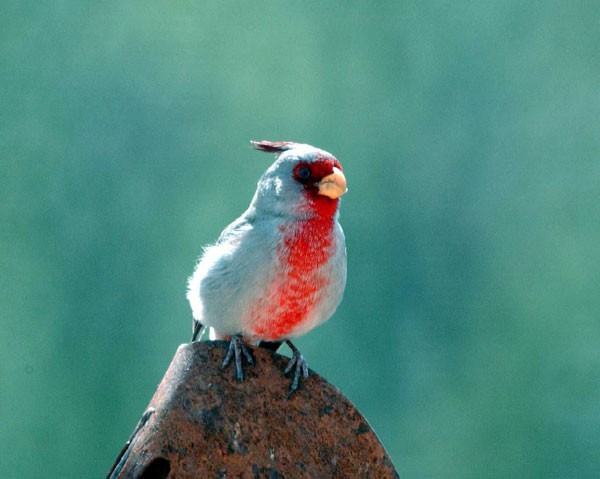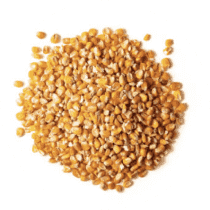Pyrrhuloxia
A species of Typical Cardinals Scientific name : Cardinalis sinuatus Genus : Typical Cardinals
Pyrrhuloxia, A species of Typical Cardinals
Botanical name: Cardinalis sinuatus
Genus: Typical Cardinals
Content
Description General Info
 Photo By Jeff dean , used under Attribution /Cropped and compressed from original
Photo By Jeff dean , used under Attribution /Cropped and compressed from original Description
The desert cardinal is a medium-sized song bird; the length for both sexes is about 8.3 in (21 cm), while the typical weight is 0.8–1.5 oz (24–43 g). The most obvious differences between the male desert cardinal and the northern cardinal are in their coloring. The desert cardinal is predominantly brownish-gray with a red breast, a red mask, and a yellow, parrot-like bill that is stout and rounded. The females of the two species resemble each other much more closely, but the shapes of their bills are diagnostic. The songs of the two species are identical, though the pyrrhuloxia's is not quite as loud. This cardinal retains the distinctive long, pointed, red crest present in all species. 
Size
22 cm (8.75 in)
Colors
Red
Gray
White
Life Expectancy
9 years
Nest Placement
Shrub
Clutch Size
2 - 4 eggs
Incubation Period
1 - 2 broods
Number of Broods
14 days
Nestling Period
10 - 13 days
Feeding Habits
Pyrrhuloxia forages on ground and in shrubbery, gleaning seeds from various grasses and plants. It supplements its diet with fruits like cactus fruits and insects, including grasshoppers and weevils. In winter, pyrrhuloxia may join large flocks to forage, and visits bird feeders.
Habitat
Pyrrhuloxia's habitat consists primarily of arid deserts and semi-arid shrublands featuring mesquite. These birds favor low to moderate elevations and thrive in hot, dry climates. Dense thorny vegetation is preferred, particularly in riparian woodlands with sycamore and cottonwood trees. Their range extends across the U.S. Southwest and much of Mexico, with minimal local movements and no significant migration.
Nest Behavior
Pyrrhuloxia's female builds the nest, with the male singing nearby. Nest building occurs within their territory with materials sourced locally.
Nest Characteristics
Pyrrhuloxia constructs a nest typically 5–15 feet off the ground in dense brush including mesquite and paloverde. The compact cup, 3 inches across and 1.5 inches deep, is made of thorny twigs, bark strips, and coarse grass, lined with rootlets, plant fibers, and feathers.
Dite type
Granivorous
General Info
Feeding Habits
Bird food type

Black Oil Sunflower Seeds

Hulled Sunflower Seeds

Cracked Corn
Bird Feeder Type

Large Tube Feeder

Large Hopper

Platform

Ground
Sounds
Call
Recording location: Mexico
Song
Recording location: Mexico
Behavior
Pyrrhuloxia demonstrates a distinctive undulating flight involving alternating wingbeats and glides. In cooler seasons, they forage for seeds in groups, breaking into territorial pairs by early spring when males display aggression and courtship, featuring unique wing-fluttering and food offerings. Pairs collaborate in nest defense and might stay together beyond breeding. Main threats include cats and local predatory birds.
Distribution Area
The pyrrhuloxia is a year-round resident of desert scrub and mesquite thickets, in the U.S. states of Arizona, New Mexico, and Texas and woodland edges in Mexico. It occupies the southwestern half of Texas, roughly the southern third of New Mexico, and southeastern region of Arizona. Its range includes areas from the west to east coast of Mexico north of the Sierra Madre del Sur, Trans-Mexican Volcanic Belt, and Isthmus of Tehuantepec, while excluding the Sierra Madre Occidental. An individual of the species has reportedly been seen as far away from its dominant range as Costa Mesa, California, in Orange County. This cardinal is relatively nonmigratory, though it may occasionally stray slightly north of its usual range. The pyrrhuloxia prefers habitat along stream beds. In areas where the range of the pyrrhuloxia and northern cardinal overlap, hybridization may occur between them. 
Species Status
Not globally threatened.
Scientific Classification
Phylum
Chordates Class
Birds Order
Perching birds Family
Cardinals Genus
Typical Cardinals Species
Pyrrhuloxia